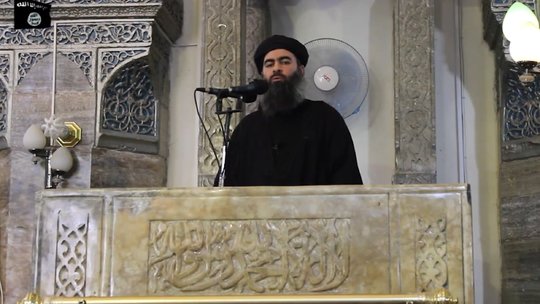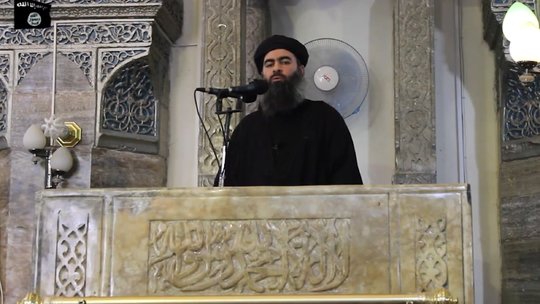 A look at Abu Bakr al-Baghdadi, the leader of the Islamic State in Iraq and Syria, a militant group that now rivals Al Qaeda in power and popularity. Video Credit By Mona El-Naggar and Sofia Perpetua on Publish Date August 11, 2014. Image Credit-/Agence France-Presse � Getty Images[/caption]
A look at Abu Bakr al-Baghdadi, the leader of the Islamic State in Iraq and Syria, a militant group that now rivals Al Qaeda in power and popularity. Video Credit By Mona El-Naggar and Sofia Perpetua on Publish Date August 11, 2014. Image Credit-/Agence France-Presse � Getty Images[/caption]BAGHDAD � As fighters for the Islamic State in Iraq and Syria continue to seize territory, the group has quietly built an effective management structure of mostly middle-aged Iraqis overseeing departments of finance, arms, local governance, military operations and recruitment.
At the top the organization is the self-declared leader of all Muslims,�Abu Bakr al-Baghdadi, a radical chief executive officer of sorts, who handpicked many of his deputies from among the men he met while a prisoner in American custody at the Camp Bucca detention center a decade ago.
He had a preference for military men, and so his leadership team includes many officers from Saddam Hussein�s long-disbanded army.
They include former Iraqi officers like Fadel al-Hayali, the top deputy for Iraq, who once served Mr. Hussein as a lieutenant colonel, and Adnan al-Sweidawi, a former lieutenant colonel who now heads the group�s military council.
�The pedigree of its leadership, outlined by an Iraqi who has seen documents seized by the Iraqi military, as well as by American intelligence officials, helps explain its battlefield successes: Its leaders augmented traditional military skill with terrorist techniques refined through years of fighting American troops, while also having deep local knowledge and contacts. ISIS is in effect a hybrid of terrorists and an army.
�These are the academies that these men graduated from to become what they are today,� said the Iraqi, a researcher named Hisham Alhashimi.
ISIS, which calls itself Islamic State, burst into global consciousness in June when its fighters seized Mosul, Iraq�s second-largest city, after moving into Iraq from their base in Syria.
The Iraqi Army melted away, and Mr. Baghdadi declared a caliphate, or Islamic state, that erased borders and imposed Taliban-like rule over a large territory. Not everyone was surprised by the group�s success. �These guys know the terrorism business inside and out, and they are the ones who survived aggressive counterterrorism campaigns during the surge,� said one American intelligence official, referring to the increase in American troops in Iraq in 2007. �They didn�t survive by being incompetent.� The official spoke on condition of anonymity because he was discussing intelligence reports.
After ISIS stormed into Mosul, one official recalled a startling phone call from a former major general in one of Mr. Hussein�s elite forces. The former general had appealed months earlier to rejoin the Iraqi Army, but the official had refused. Now the general was fighting for ISIS and threatened revenge.
�We will reach you soon, and I will chop you into pieces,� he said, according to the official, Bikhtiyar al-Qadi, of the commission that bars some former members of Mr. Hussein�s Baath Party from government posts.
ISIS�s success has alarmed American and regional security officials, who say it fights more like an army than
The group has also received support from other armed Sunni groups and former members of the Baath Party � which was founded as a secular movement � angry over their loss of status.
�In the terrorism game, these guys are at the center of a near perfect storm of factors,� the American official said.
Mr. Baghdadi�s deputies include 12 walis, or local rulers; a three-man war cabinet; and eight others who manage portfolios like finance, prisoners and recruitment.
Its operations are carried out by a network of regional commanders who have their own subordinates and a degree of autonomy, but they have set �drop times� when they open a shared network to coordinate.
For example, ISIS responded to American airstrikes on its positions in Iraq by distributing a professionally produced video last week of the beheading of the American journalist James Foley more than 200 miles away.
ISIS is the current incarnation of Al Qaeda in Iraq, the insurgent group that battled American forces under the leadership of Abu Musab Al-Zarqawi before his death from an American airstrike in 2006.
According to a map of the group developed by Mr. Alhashimi, the Iraqi expert, Mr. Baghdadi has 25 deputies across Iraq and Syria. About one-third were military officers during Mr. Hussein�s rule, and nearly all were imprisoned by American forces.
The last two leaders of ISIS�s military council were former Iraqi military officers: a colonel and a captain. Both have been killed � and have been followed by a former lieutenant colonel, Adnan al-Sweidawi, who is about 50 years old.
Ahmed al-Dulaimi, the governor of Anbar Province, which is now largely controlled by ISIS, said that all three men graduated from the same military academy.
Mr. Dulaimi said he had taught one of them, Adnan Nijim, who graduated in 1993 to become an infantry officer.
�It was never clear that he would turn out like that,� Mr. Dulaimi said. �He was from a simple family, with high morals, but all his brothers went in that direction,� becoming jihadists.
After the United States invaded Iraq in 2003, Mr. Nijim joined Al Qaeda in Iraq and was detained by American forces in 2005, Mr. Dulaimi said.
�All of these guys got religious after 2003,� Mr. Dulaimi said. �Surely, ISIS benefits from their experience.�
Other former military brass have also fought for ISIS.
Mr. Baghdadi�s top deputy in Syria, Samir al-Khlifawi, was a colonel. He was killed in Syria by other insurgents.
Derek Harvey, a former Army intelligence officer and specialist on Iraq who now directs the University of South Florida�s Global Initiative for Civil Society and Conflict, said that former officers also had professional, personal and tribal relationships that had strengthened ISIS�s coalition.
The group�s campaign to free hundreds of militants from�Iraqi prisons�was executed with former Baath Party
Hassan Abu Hanieh, a Jordanian expert on Islamist groups, said that while Mr. Baghdadi had relied mostly on Iraqis, he had left areas like religious guidance, recruitment and media production to foreigners.
Many of them, like the head of ISIS�s media department, are Saudis. This is at least partly to make ISIS appear �globalized,� Mr. Abu Hanieh said. �They want to appeal to international jihadists so that they come and join the battle.�
Some non-Iraqis have risen to prominence. Mr. Baghdadi�s chief spokesman is Syrian. And one group of foreign fighters is led by an ethnic Chechen who goes by the name Omar al-Shishani.
Michael Knights, an Iraq analyst at the Washington Institute for Near East Policy, said it was no surprise that so many officers from Mr. Hussein�s era had joined ISIS. Discontent in the military was widespread near the end of his rule, and underground Islamist movements were gaining strength, even inside the military, he said.
Political changes after the American invasion accelerated their rise. Members of Mr. Hussein�s Baath Party were barred from government positions, and the political dominance of Iraq�s Shiite majority made many Sunnis feel disenfranchised.
�After 2003, what did these guys have to do but get more radical?� Mr. Knights said.
For those who had served in Mr. Hussein�s staunchly secular army, that transformation was complete by the time they joined ISIS. �There is no one in Baghdadi�s state who is not a believer,� Mr. Alhashimi said.
This article was written by BEN HUBBARD� for the New York Times on AUG. 27, 2014,�and Eric Schmitt from Washington. Reporting was contributed by Omar al-Jawoshy from Baghdad, Karam Shoumali from Istanbul, and Hwaida Saad and Mohammed Ghannam from Beirut, Lebanon.
The Iran Project is not responsible for the content of quoted articles.











